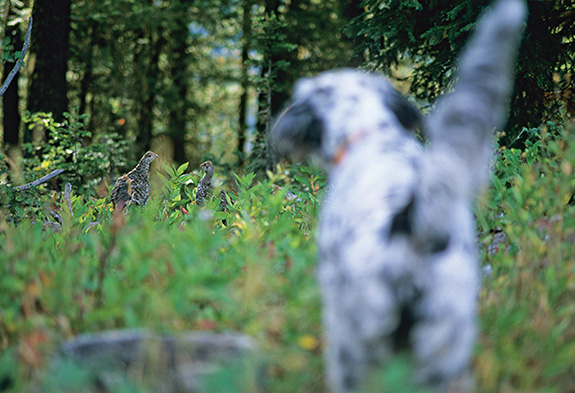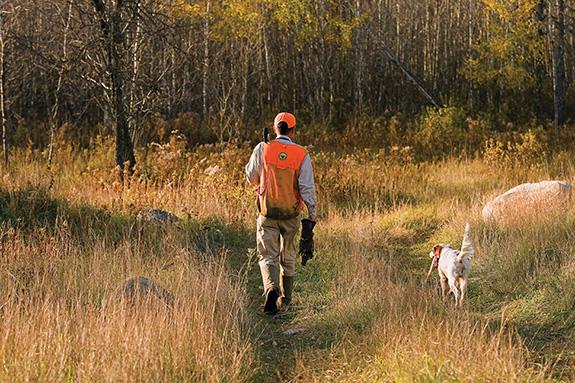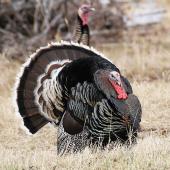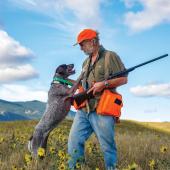The Quiet Road
This season, retreat to the high country in search of mountain grouse.
Evening is the quiet road. The hunt is squeezed by daylight; the ridge has been climbed in a frenzy of pumping heart and heaving lung. The shotgun has barked, once, twice. Fresh dog work for the young Griffon; old hat for the tottering legs-wobbling grayed setter. A single blue grouse lies warm against your back and shooting light is slipping by.
You turn, head down the mountain, chasing the fading sun. An elk chortles off in the timber, undaunted by the sound of shotgun and whistle, dog-holler and grouse-burst. Poisoned by lust, judgment suspect. Down the ridge now, dead bird and fading sunlight, down past all of that hard hurried late-afternoon work, down to cold beer. Another day is down, another day in this best of all the best.
There is nothing quite like the hunt of the mountain grouse. The hills are quiet in a window before big-game season starts. Sure, you may stumble across an archery hunter while you’re out there, appearing like an apparition in camouflage. But for the most part, September and early October are all yours. It even feels as if most people have stopped hiking at the end of August, as if there’s a law or something.
Hunting mountain grouse, though, is hiking with a shotgun—rigorous hiking. Occasionally stopping and yelling for your dog, or blowing on a whistle, too. Bursting out that precious air from your tired lungs.
But, if you work hard, hike well, and swing that shotgun, perhaps you’ll experience that quiet road when the day is done, there’s a bird in the vest, the dog is all panting-happy, and a bull elk calls from the timber wishing you farewell. There’s nothing quite like that moment in a hunter’s journey.

In this corner of the world, there are two mountain grouse species. I’ve found a third—spruce grouse—in the Pintler Range, which is technically southwest Montana, but just barely. And spruce grouse are pretty uncommon in this region generally.
But the other two are something else entirely: ruffed grouse and blue grouse. If you’re an elk hunter, you probably call them both fool hens, for their fear of man on his own is not very fierce. They act plumb dumb. They walk on the ground only a few feet from you and when they fly, they land in a tree just above your head and sit there. A rock is a pretty good method of turning one into dinner.
Add a dog to the equation, and all of a sudden, the game changes. Perhaps the bird keys off on a canine cousin, Mr. Coyote. They don’t stick around very long when you’re hunting with a good bird dog. They flush wild, fly at crazy angles, leave the territory never to be seen again.
Blue, or dusky, grouse are typically birds of timbered ridges and ruffed grouse are commonly found along drainages near alder, aspen, and willow.
Hunting blue grouse means climbing. They are a strange bird that reverse-migrates. When most animals go down out of the mountains with the seasons, blue grouse go up. Early in the season, you might find them low down in the ruffed-grouse coulees, particularly broods of hens with young-of-the-year. Hunt those same places you’d find ruffed grouse and you’ll probably do okay.
But go back to that same spot two weeks later and it’s a pretty good bet you won’t find anything. That’s because mother hen has moved her babies up, up into the timber, up out of the low country. A week later, higher still. Blue grouse winter on the highest ridges where they eat spruce or fir needles to survive the season. As spring comes, down they go to the foothills.
Generally speaking, key on ridges with good stands of Douglas fir of all age classes. If you’re in the lodgepole pine, you’re less likely to find blues. Work right along the top of the ridge and be prepared for some crazy shooting. I think a fast-moving blue grouse that’s dropping down and away faster than you can read this sentence is one of the hardest shots to make in shotgunning.
Ruffed grouse will give you a different game. You’ll want your dog to hunt close and you may want to have a bell on him or a beeper collar. The thicker the cover, the kind of cover that slaps you in the face and pokes you in the eye, the better for ruffed grouse. Thick aspen and alder stands are the idea. If there’s just a dusting of snow, enough to find tracks, all the better. Later in the season, after the leaves drop, is better still. When you find ruffed grouse, chances are you’ll only find one and he’ll be going fast—bursting is a better word.
Here’s another challenge all its own: shoot fast. Swinging? If you’ve got the window—but chances are, you’ll be in such thick cover, you’ll bang your shotgun barrel off an aspen trunk. Don’t worry about trees. Shoot through them and maybe you’ll connect with something more than leaf and twig.

You can hunt grouse without one, but the essence of upland hunting is having a good dog. Any good bird dog will work. Labs and goldens are great for grouse hunting, ruffed or blue. They’ll work close, flush the bird, bring it back to you if you knock one down.
Close-working pointing dogs make fine partners, too. There’s nothing quite like walking in on a point of a ruffed or a blue grouse. There’s a tension between the point and the flush that is a buzz like nothing else in the sporting world. Anticipation doesn’t quite describe it.
If you do work a pointing dog, work it close, because neither grouse sticks around very long after it’s discovered. And yes, they’ll sometimes fly up in trees and sit there. They make for delicious eating—you decide if they’re appetizing enough to shoot out of the tree instead of on the wing.










